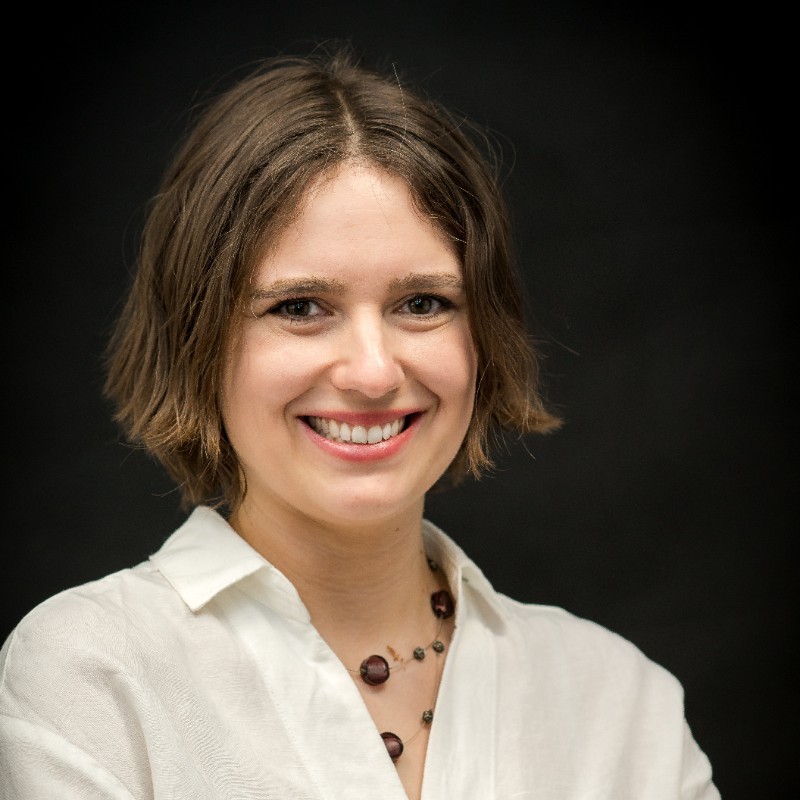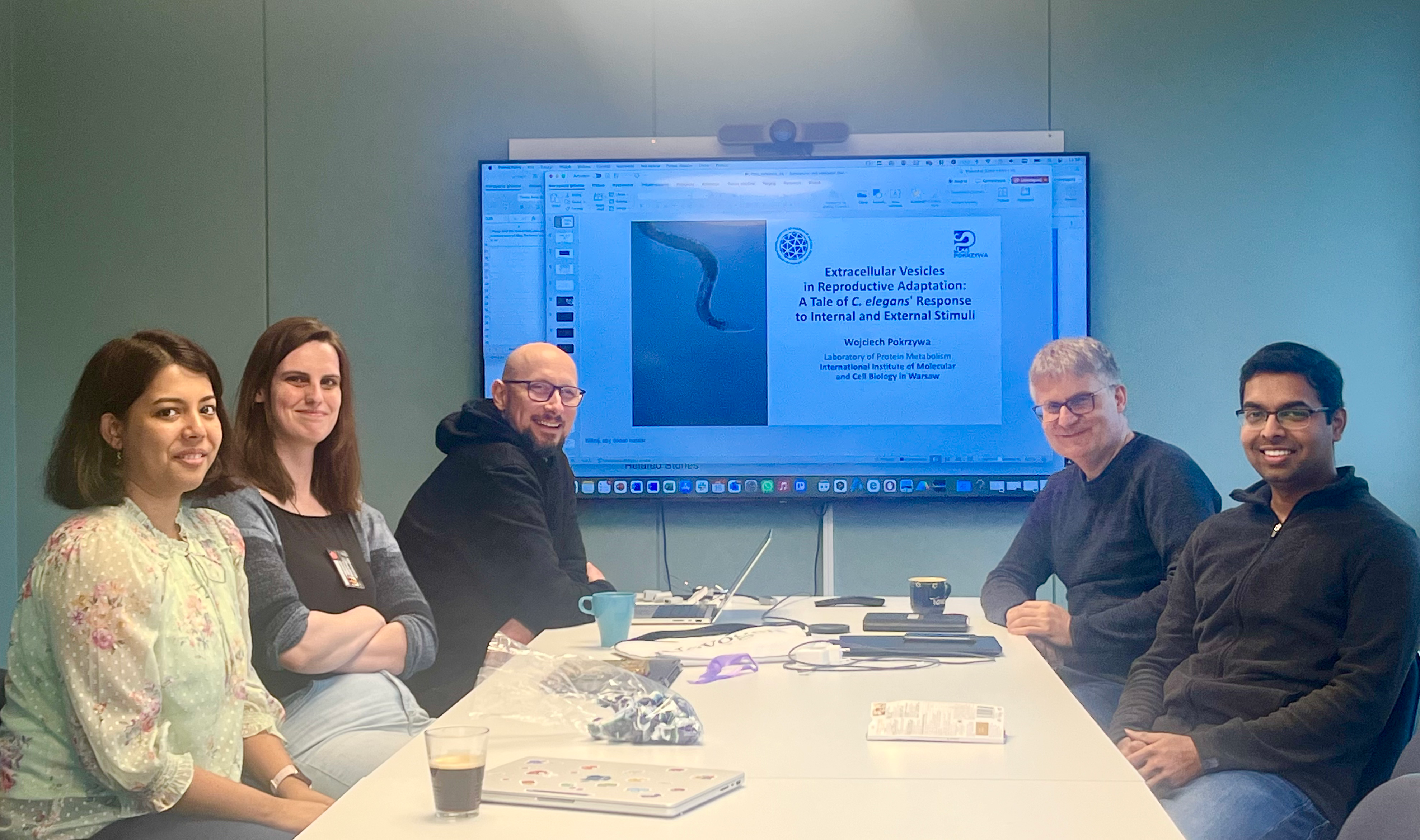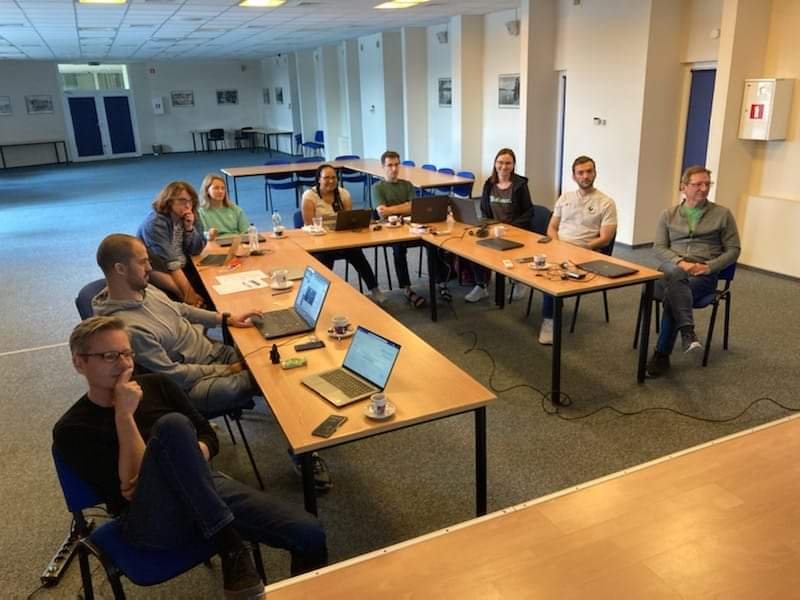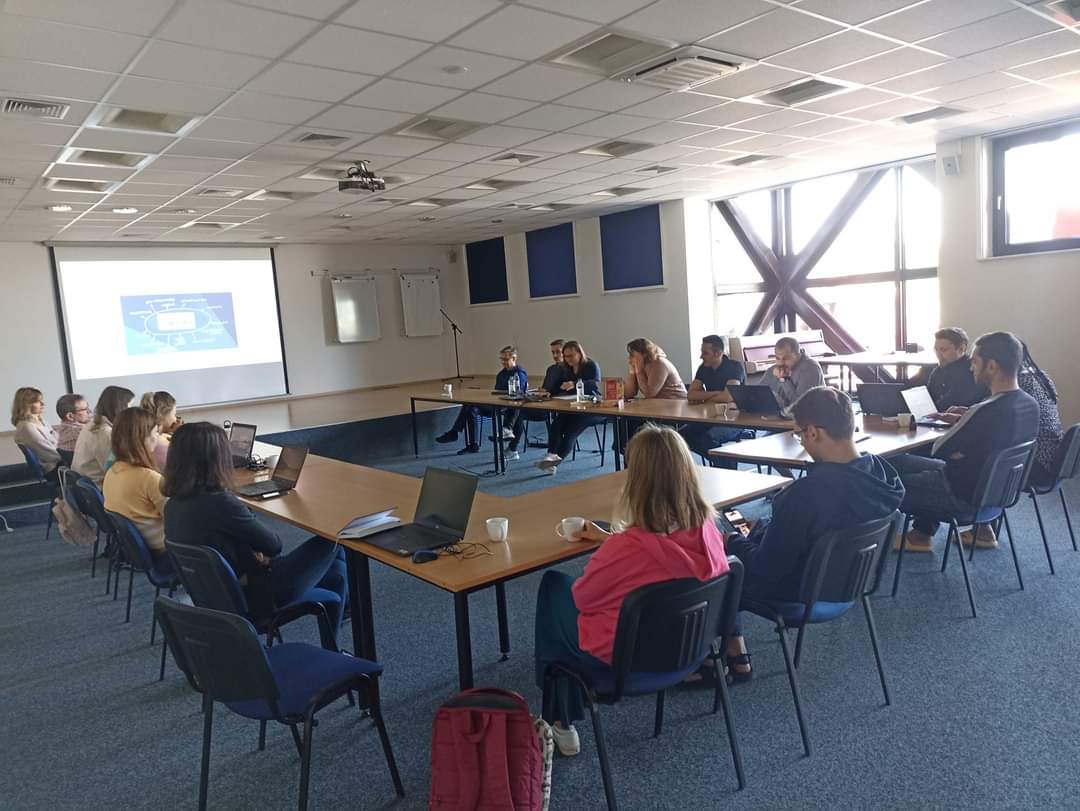
Project title: RNA and Cell Biology Platform for Research and Innovation in Medicine
Acronym: RACE-PRIME
Project value: 36 293 600 PLN
EU Funding: 36 293 600 PLN
Implementation period: 1.05.2024-30.04.2029
Project number: FENG.02.01-IP.05-T003/23
Programme: International Research Agendas, funded by the European Funds for Smart Economy 2021-2027 programme (FENG)
- Researchers and students in biological sciences
- Business in biological sciences
- Policy makers in science
- Citizens, including young society
Job Offers Newsletter from the International Institute of Molecular and Cell Biology in Warsaw (IIMCB)

E-learning training in English for persons planning to work with laboratory animals
The International Institute of Molecular and Cell Biology in Warsaw (IIMCB) in collaboration with the Polish Laboratory Animal Science Association (PolLASA) offers theoretical e-learning training preparing for work with animals used in research or for educational purposes.
The training includes a compulsory section on the zebrafish animal model.
- Theoretical e-learning training is aimed at:
- persons participating in procedures,
- persons performing procedures,
- persons killing animals used in procedures,
- persons responsible for the planning of procedures and experiments and for their execution.
The training program complies with the requirements of the Polish law and Article 23 of the European Directive 2010/63/EU on the protection of animals used for scientific purposes.
This training, conducted entirely in English, is dedicated exclusively for non-Polish speakers.
Persons speaking Polish are kindly requested to use training courses offered by PolLASA.
To obtain the appropriate assignment, in addition to passing theoretical training, it is necessary to complete practical training and internships at home institution in accordance with applicable legal requirements.
If interested, please contact the IIMCB Scientific Coordination Unit This email address is being protected from spambots. You need JavaScript enabled to view it..
The e-learning platform is funded from the MOSaIC ERA Chairs H2020 project.

Animal Research at the IIMCB
Participation of different animals in scientific research at the IIMCB:
| 2018-2024 | |
| Mice | 12 314 (56%) |
| Zebrafish | 4 043 (18%) |
| Rats | 5 707 (26%) |
Most common procedures using animals:
1. Tissue collection – animals are not subjected to any procedures during their lifetime. They are killed and the isolated tissues are then used, for example, to derive cell lines, or for molecular studies for further detailed research.
2. Experiments using animals; most common procedures using animals include:
a) Hormonal stimulation – administration of two injections containing hormones to stimulate ovulation. This procedure is analogous to preparing women for egg cell retrieval in in vitro procedures (although the number of injections is much fewer). The procedure allows us to obtain a large number of embryos, which can then be genetically modified.
b) Vasectomy – a surgical procedure performed under general anaesthesia and with intra – and postoperative pain protection. Vasectomy is used to obtain infertile males - they mate with females to “prepare” them to receive modified embryos via embryo transfer. Embryo transfer without prior preparation of females by mating with infertile males (not producing sperm, but sexually capable) is ineffective.
c) Embryo transfer – a surgical procedure involving the transfer of embryos into the fallopian tubes of recipient females. The operation is performed using a microscope, under general anesthesia, with intra- and postoperative pain protection.
d) Breeding mice with potentially harmful characteristics (phenotypes) – after developing a new line of genetically modified mice, all are observed to check if the changes have negatively affected their welfare.
e) Intramuscular injection – analogous to the methods used in humans for administering drugs and vaccines.
f) Sensory-motor behavioural tests – this test is used to determine the overall level of activity and exploratory habits in rodent models of central nervous system disorders. The animal is placed in an arena (round/square box) and allowed to move freely for 10 minutes while being recorded by a camera. The video material is then analysed by an automated tracking system. The following parameters are considered: distance travelled, speed, and time spent in previously defined zones. This simple test is useful in assessing the impact of applied therapies on overall activity.
Ongoing Research:
 mRNA (A type of RNA that carries genetic information)
mRNA (A type of RNA that carries genetic information)
1. Studying the stability and effectiveness of mRNA vaccines in various tissues. Results will help the design of targeted vaccines for specific organs.
2. Developing technology to enhance the stability and efficient replication of synthetic mRNA introduced into cells, aiming to create new anti-cancer vaccines and immunotherapeutic solutions.
3. Investigating the efficiency of delivering nanoparticles containing mRNA to different types of cells: improving therapeutic mRNA technology to develop anti-cancer mRNA vaccines.
4. Examining the mRNA release process (enclosed in lipid nanoparticles) from endosomal vesicles (responsible for transporting substances from the environment into the cell) into the cytoplasm. It is estimated that only a few to several percent of the mRNA delivered to the cell is released into the cytoplasm. Understanding this process may help increase the efficiency of therapeutic mRNA vaccines.
5. We are studying how the mouse body processes mRNA-based drugs in the absence of specific enzymes responsible for their degradation in selected tissues. The goal is to build a foundation for creating precise mRNA therapies that target specific organs.
Mutations in Genes Causing Diseases
1. Studying the effects of mutations in the mitochondrial genome across different tissues in mice. In the human population, mitochondrial disorders affect 1 in 5,000 people, causing serious nervous system and musculoskeletal symptoms for which there is currently no effective treatment available.
2. Creating a line of mice that lack a gene encoding a protein, whose inhibitor (blocking substance) may become a new drug in breast cancer treatment.
3. Researching the effectiveness of melanoma anti-cancer treatment – a dangerous malignant skin tumour detected in about 110,000 patients annually.
4. We are studying zebrafish with a genetic mutation that causes behaviors similar to autism. These include changes in social interaction, response to new stimuli, and activity of genes involved in brain development.
Brain Research (Depression)
1. An investigation of the brain of animals to see if disturbing the activity of certain selected genes leads to the same changes as those obtained in cellular studies. Checking whether these changes will affect behaviours typical of depression (e.g., increased level of helplessness) and weaken their ability to think effectively (e.g., during learning).
2. Testing in animals the antidepressant potential of 21 substances selected based on specific pharmacological characteristics. If the results are positive, collaboration with clinicians will begin to develop a pilot clinical trial. Searching for new antidepressant drugs is necessary as currently available therapies are only effective in 50% of cases, and many individuals do not respond to subsequent treatment attempts (treatment-resistant depression).
Immune System Response Research
1. Analysing the immune system response (innate immunity) to modified RNA molecules representing both viral RNA and host RNA (mice). The findings of this research will help to understand how best to prevent and treat serious viral and autoimmune diseases.
2. Studying the effects of inflammation caused by bacterial endotoxin (LPS) in mice with iron deficiency to understand the development of anaemia during infections and inflammatory diseases.
Gut Microbiota and Liver Function
1. We are investigating how gut bacteria (microbiota) affect liver inflammation after exposure to a toxic substance found in the death cap mushroom. We are also examining how this toxin impacts liver cells and exploring ways to stop disease progression.
2. We study how liver cirrhosis affects gut function to discover new treatment strategies.
3. We are analyzing how the gut and liver interact during cirrhosis, focusing on the role of gut microbes in disease development and how liver damage changes the makeup and function of gut microorganisms.
Iron Balance in the Body
1. We are studying how the body removes free hemoglobin under normal conditions and during hemolysis – breakdown process of red blood cells, which happens in many diseases.
2. We are analyzing new mechanisms that regulate iron recycling from red blood cells in mice with iron-deficient diets. The insufficiency of this element represents a global medical challenge.
Animal Models of Human Diseases
By changing certain genes in animals, we can recreate diseases seen in humans. These animal models help us understand disease mechanisms and develop better treatments.
Zebrafish – introduced mutations:
- linked to Parkinson’s disease
- causing heart defects during development
- affecting inner ear development and hearing
Mice – introduced mutations:
- causing the following diseases:
- muscular dystrophy
- unknown metabolic disorders
- neurodevelopmental conditions
- autism spectrum disorder
- leukemia - causing drug intolerance in leukemia treatment
- affecting the formation of blood vessels
Learn more:
Animal Research
The Importance of Animal Research
Research Guidelines
Animal Research at the IIMCB
Research Guidelines
Laboratory animals are used in research only when the use of other models is not possible and when it is justified by the objective of the study.
Legal Regulations
 1. Animal research is regulated by European and national laws: Directive 2010/63/EU of the European Parliament and of the Council on the protection of animals used for scientific purposes, Polish Act on the protection of animals used for scientific or educational purposes of January 15 2015, (Journal of Laws 2015, item 266, with later amendments), Polish Decree of the Minister of Education and Science, on training, internships, and apprenticeships for persons involved in the use of animals for scientific or educational purposes of November 30 2022, (Journal of Laws 2022, item 2576).
1. Animal research is regulated by European and national laws: Directive 2010/63/EU of the European Parliament and of the Council on the protection of animals used for scientific purposes, Polish Act on the protection of animals used for scientific or educational purposes of January 15 2015, (Journal of Laws 2015, item 266, with later amendments), Polish Decree of the Minister of Education and Science, on training, internships, and apprenticeships for persons involved in the use of animals for scientific or educational purposes of November 30 2022, (Journal of Laws 2022, item 2576).
2. Each study including procedures on animals must be approved by the Local Committee for Ethics in Animal Research (LKE).
3. When applying for permission from the LKE, it is necessary to present, among other things:
a) the purpose, experiment description, procedures used, and the expected severity for the animals;
b) justification for the choice of animal species and the number of animals involved in the study, which must be statistically determined to achieve the research objectives with the minimum number of individuals;
c) justification for applying the 3R principles in the planned research;
d) a non-technical summary, which is part of publicly available information about planned experiments and the outcomes for the animals.
4. Prior to submission to LKE, each application is reviewed and approved by the Animal Welfare Team operating within the institution.
5. To conduct animal research, scientists must obtain “an assignment” – a document confirming that they have completed theoretical and practical courses and appropriate practical training.
6. Animal facilities are subject to announced and unannounced external inspections conducted by the District Veterinary Officer and internal inspections conducted by the Animal Welfare Team.
Each year the Animal Welfare Team at the Institute conducts several internal inspections of animal husbandry and animal condition, as well as of selected experiments involving animals.
3Rs Principle
 The 3Rs principle (Replacement, Reduction, Refinement) includes guidelines that should be followed when planning and conducting experiments on animals. Its purpose is to reduce the use of animals in laboratory research and improve their welfare.
The 3Rs principle (Replacement, Reduction, Refinement) includes guidelines that should be followed when planning and conducting experiments on animals. Its purpose is to reduce the use of animals in laboratory research and improve their welfare.
3Rs Principle
Replacement – use of alternative research methods instead of studies involving animals.
Reduction – reducing the number of animals tested to the necessary minimum while maintaining the reliability of statistical data.
Refinement – minimizing stress and suffering of animals by optimizing their environment conditions and performing procedures using the most advanced methods to improve animal welfare in the experiment.
We train in conducting animal research
In cooperation with the Polish Laboratory Animal Science Association (PolLASA), we provide theoretical training in English for foreigners from various scientific institutions in the country. Our course includes a mandatory panel on working with zebrafish and their embryos. The use of zebrafish larvae in animal research is an alternative method, which follows the rule of replacement. READ MORE
Learn more:
Animal Research
The Importance of Animal Research
Research Guidelines
Animal Research at the IIMCB
The Importance of Animal Research
 Without the use of laboratory animals, we would not be able to answer many scientific and medical questions. Laboratory animal organisms are in many ways similar to humans: 99% of the genome of a laboratory mouse and 70% of the genome of zebrafish are identical to the human genome. Although alternative research methods are being rapidly developed, they still do not fully replace in vivo methods (studies on animal models).
Without the use of laboratory animals, we would not be able to answer many scientific and medical questions. Laboratory animal organisms are in many ways similar to humans: 99% of the genome of a laboratory mouse and 70% of the genome of zebrafish are identical to the human genome. Although alternative research methods are being rapidly developed, they still do not fully replace in vivo methods (studies on animal models).
Scientific research involving laboratory animals allows us to understand complex processes occurring between different types of cells and tissues that we cannot observe in cell cultures. Currently, even the most advanced non-animal methods, such as organoids (lab-grown organs), cannot fully replicate the complexity of development and functioning of a living organism.
Selected research findings obtained using animals in the IIMCB
Medicine
1. Our research published in Nature revealed that the enzyme TENT5A plays a key role in protecting therapeutic mRNA from breaking down inside cells. It does this by extending the molecules' poly(A) tails – protective endings that help keep mRNA stable. This discovery helps explain why COVID-19 vaccines work so well and opens up possibilities for designing more effective mRNA-based treatments (mice, Krawczyk et al., 2025).
2. We developed an innovative tool called Ninetails, which uses artificial intelligence to precisely analyze the ends of mRNA molecules. We found that these ends are more diverse than previously thought. This diversity matters greatly for the stability and effectiveness of mRNA-based medicines, including vaccines (mice, Gumińska et al., 2025).
3. We discovered that synthetic RNA molecules starting with a specific building block – adenosine – trigger a stronger immune response in mice than those starting with guanosine. This could lead to the development of safer and more effective RNA-based vaccines and therapies (mice, Wolczyk et al., 2024).
4. We showed that certain liver cells respond to excess iron by activating a process that brings its levels back to normal. This insight may help treat diseases linked to problems with iron balance in the body (mice, Żurawska et al., 2024).
5. Our research found that one of the earliest signs of aging is a problem in recovering iron from red blood cells. This is due to weakened function of special cells in the spleen. Studies in mice showed that this process can be slowed down by reducing iron intake through diet (mice, Slusarczyk et al., 2023).
6. We discovered that mRNA vaccines (such as ones used for Covid19) are stabilized by proteins present in cells and only thanks to them immunity against diseases is formed (mice, Krawczyk et al., 2023).
7. We found the causes of congenital bone fragility in children with a mutation in the TENT5A gene (mice, Gewartowska et al., 2021).
8. We discovered how mutations in the Tent5c gene contribute to the development of multiple myeloma (a type of blood cancer) and how Tent5c affects the immune system (mice, Mroczek et al., 2017 and Bilska et al., 2020).
9. Using CRISPR-Cas9 technology, we developed lines of zebrafish with mutations in npc genes. It has helped to better understand Niemann-Pick disease, which causes damage to multiple organs in the body. Our findings may accelerate therapy development (zebrafish, Wiweger et al., 2021).
10. Through research on microRNA-7, we revealed how microRNA affects neuronal development, which could potentially be applied in therapies for neurodegenerative diseases such as Parkinson's disease (zebrafish, Adusumilli et al., 2020).
11. Through research on fish with a Tsc2 deficiency, we demonstrated hyperactivity of the mTorC1 pathway and unproper development of connections between neuronal cells, which can be important for development of therapies of neuropsychiatric symptoms in patients suffering from tuberous sclerosis (zebrafish, Kedra et al., 2020 and Prentzell et al., 2021).
Developmental biology
1. We demonstrated that proteins from the TENT5 family are essential for the proper development of reproductive cells – egg cells and sperm. Understanding this process better may support efforts to diagnose and treat infertility (mice, Brouze et al., 2024).
2. Thanks to the use of integrated genomics tools, we identified molecular factors responsible for congenital heart defects (zebrafish, Baranasic et al., 2022).
3. We learned about the molecular mechanisms of heart regeneration in zebrafish, which may contribute to a better understanding of why heart regeneration does not happen naturally in humans. It may also help selecting individual therapies for patients after heart attack (zebrafish, Pawlak et al., 2019).
4. We discovered the function of ADAR enzymes that convert adenosine to inosine, which is crucial for the proper development of embryos and the immune response (zebrafish, Niescierowicz et al., 2022).
5. We found that the proper development and function of the inner ear depend on potassium ion concentration involving the Kv2.1/KCNB1 protein (zebrafish, Jedrychowska et al., 2021).
6. Studies of the Wnt3 protein provided us with insights into its distribution and functions in the brain of fish, which is important for understanding the developmental mechanisms of the vertebrate brain (zebrafish, Veerapathiran et al., 2020).
Cell biology of ageing processes
1. We discovered a new mechanism that controls how lysosomes move inside cells. Lysosomes are tiny sacs that help clean up cell waste. This research may improve our understanding of how cells age and how they react to stress (rats, Tempes et al., 2024).
2. We found that the STIM2 protein plays a key role in processing visual signals and in producing insulin in brain cells. A lack of this protein can cause changes in the retina similar to those seen in glaucoma. These findings create new opportunities to explore the link between calcium signals, insulin, and brain function (zebrafish, Baranykova et al., 2024).
Learn more:
Animal Research
The Importance of Animal Research
Research Guidelines
Animal Research at the IIMCB
Animal Research
At the International Institute of Molecular and Cell Biology in Warsaw, we conduct basic and applied research at the levels of molecules, organelles, cells, tissues and organisms. Our goal is to expand current knowledge and contribute to the development of medical therapies. We focus on neurological and rare diseases, cancers, and the development of next-generation drugs based on RNA technologies.
The range of techniques and research models we employ at the Institute is extensive, including computer modeling, biochemical experiments on proteins produced by bacteria, and research on cell lines, organoids, and lower organisms such as nematodes. Additionally, we conduct research using laboratory animals, such as zebrafish, mice, and rats. In planning and conducting this research, we adhere to EU and national regulations as well as the 3Rs principle of replacement, reduction, and refinement.
Laboratory animals are used in research only when other methods are not possible and when the research goal justifies it.
"We are committed to conduct research responsibly, i.e., using animals in scientific research only when other methods cannot be applied. We are also dedicated to transparent communication in this area," says Olga Gewartowska, head of the Genome Engineering Facility at the IIMCB and a member of the Polish National Committee for Ethics in Animal Research.
Contact:
If you have questions, email us at: This email address is being protected from spambots. You need JavaScript enabled to view it.
Learn more:
Animal Research
The Importance of Animal Research
Research Guidelines
Animal Research at the IIMCB
|
The IIMCB is a member of the European Animal Research Association (EARA), an organization that promotes transparency and communication about the use of animals in scientific research across Europe. Among its various initiatives, EARA organizes the EARA Patient Day, an event that brings together patients, scientists, and clinicians to highlight the role of biomedical research in developing new treatments. More information about EARA Patient Day is available here: https://www.eara.eu/patient-discovery |
The P.I. of the Laboratory of Protein Metabolism at IIMCB in Warsaw, Dr. Wojciech Pokrzywa, accompanied by doctoral students Natalia and Anwesha, had the opportunity to travel to the University of Oslo to meet with their Norwegian partner, Prof. Rafal Ciosk, and his team. The primary objective of this visit was to assess the progress of their collaborative research funded by the GRIEG grant and to strategize for forthcoming research initiatives.

A fruitful grant meeting is behind us! An interesting discussion, exchange of ideas and plans for further research. Dziembowska lab from CeNT UW, Bramham lab from UiB and Dziembowski lab from IIMCB (+Radwańska lab from Nencki Institute) have a networking session in Wierzba PAN!



